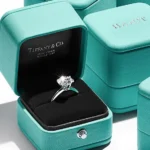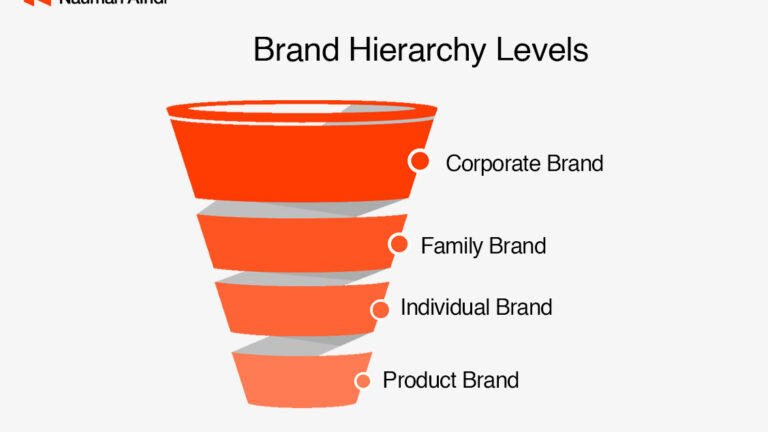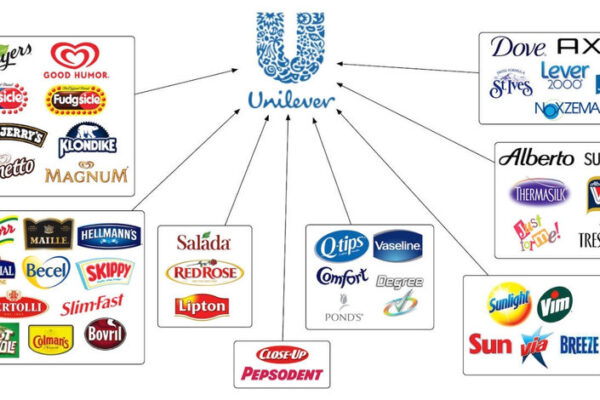Brands serve as beacons of trust, reliability, and quality amidst a sea of choices. From the iconic golden arches of McDonald’s to the sleek, bitten apple of Apple Inc., brands wield immense power in shaping consumer preferences. But within each brand lies a structured system that delineates its various offerings – a system known as brand hierarchy.
Brand hierarchy is not just advantageous but imperative for businesses striving to carve their niche. It’s the key to unlocking the intricacies of product differentiation and establishing a cohesive identity within a brand’s ecosystem.
Consider, for instance, the offerings of a tech giant like Dell. Amidst a plethora of laptops bearing the Dell logo, what sets apart the Inspiron 14 from the Inspiron 15? Beyond mere technical specifications, it’s the brand hierarchy that elucidates their distinctions and guides consumer choices.
In this blog post, we will look into its significance, explore its architectural nuances, and uncover how it shapes consumer perceptions and purchasing decisions
What Is It Brand Hierarchy
An organizational brand strategy called brand hierarchy gives a portfolio of brands a structure.
Organizations often have connections and partnerships with other brands, creating part of a wider organizational structure of brands that is sometimes referred to as a brand portfolio. This is because brands do not exist in silos.
When we picture a typical corporate organizational chart, we probably see a few executives at the top, followed by middle management, line managers, and non-managerial positions.
In a company, this is basically the personnel hierarchy.
As a component of a larger brand strategy, brand hierarchy provides structure and organization to a portfolio of brands rather than individuals.
What Makes Brand Hierarchy Vital?
A brand’s ability to establish a consistent identity and image in the marketplace depends on its brand hierarchy.
It makes a brand’s goods and services easier for its target market to recognize and distinguish from those of its rivals.
In addition to giving the market clarity, it acts as a framework for efficiently managing the brand’s portfolio as well as a structural roadmap and compass for product development and brand growth.
Brand Architecture vs. Brand Hierarchy?
What distinguishes brand architecture from brand hierarchy, then?
Well, although the phrases are often used synonymously, brand hierarchy and brand architecture are two distinct ideas.
The general arrangement of a company’s brands and their interrelationships are referred to as its brand architecture.
Conversely, brand hierarchy describes how items and brands are arranged inside the larger framework of a brand.
Stated differently, brand architecture includes brand hierarchy as a component. The hierarchy’s main goal is to arrange the many brands and goods that make up the brand family.
Examples of Brand hierarchy
Depending on the company’s overall branding strategy, marketing plan, industry, and market position, brand hierarchy may take on a wide variety of models and structures.
In order to keep the market clear and prevent misunderstanding, these components are crucial for the brand to take into account.
Brand hierarchy is a sound business approach to improve clarity and lessen consumer confusion, whether you’re creating a new brand with new items or maintaining an old brand with existing products.
Here are five instances of different brand hierarchies.
Apple’s Monolithic Brand Hierarchy
When a brand positions and markets all of its goods and services under a single name, this is known as a monolithic brand hierarchy.
For instance, Apple has a monolithic brand hierarchy structure in which the company markets all of its individual products under the Apple corporate brand, ranging from the iPhone to the Macbook to the iMac and everything in between.
For smaller firms that want to be transparent about the goods and services they provide, this is a great choice.
Nestle’s Endorsed Brand Hierarchy
This is a system in which a parent brand that supports each individual sub-brand places its goods and services beneath it as sub-brands.
For instance, KitKat, Nescafe, and Nestea are only a few product lines and sub-brands that Nestle, the parent company, endorses using the approved hierarchy structure.
Compared to the monolithic structure, this method gives the sub-brands a bit more latitude to diverge from the appearance, personality, and feel of the parent brands.
By using this strategy, each sub-brand clearly presents the parent brand while still having its own distinct visual identity.
FedEx Branded House Hierarchy
With a name, position, and target market assigned to each sub-brand, a branded house strategy gives structure to a portfolio of brands in which the sub-brands distinctly capitalize on the reputation and equity of the parent brand.
A few excellent instances of branded housing strategies are FedEx and Virgin.
Virgin Atlantic, Virgin Media, and Virgin Money are just a few of the Virgin sub-brands that are obviously under the parent company Virgin’s umbrella.
P&G House of Brands Hierarchy
Out of all the brand hierarchy methods, the House Of Brands Hierarchy is the most autonomous brand strategy.
By using this strategy, the parent company may showcase a portfolio of autonomous brands, each with a unique identity, positioning, personality, message, and target market.
using comparable goods that appeal to different groups, parent brands may service a broad range of markets and market segments using this strategy.
Procter & Gamble and Unilever are the two companies that best exemplify the house of brands approach.
With 65 brands across 10 product categories, Proctor & Gamble is home to well-known brands including Pampers, Gilette, and Tide.
Marriott Hotels-Endorsed Brand Hierarchy
Parent brands and sub-brands benefit from a hybrid brand hierarchy that combines the independence and flexibility of the house of brands strategy with the connotations and brand equity of an authorized brand approach.
The Marriot Hotel, which has distinct sub-brands for each of its hotels and resorts, is a great illustration of a hybrid brand hierarchy.
While some of these sub-brands, like the Ritz-Carlton, Westin, and Sheraton, are part of the House of Brand framework, others, like the Marriot Executive Apartments and the Marriot Courtyard, make use of the approved brand strategy.
Product Portfolio vs. Brand Portfolio
Although there is a distinction, the terms “product portfolio” and “brand portfolio” are also sometimes used synonymously.
A product portfolio is the assortment of goods and services that a business provides, while a brand portfolio is the collection of brands that a business owns or oversees.
A brand hierarchy provides a framework and a strategic direction for management in terms of product creation and growth, assisting in the efficient administration of both brand and product portfolios.
What Levels Does the Brand Hierarchy Have?

The brand family has a distinct conceptual and visual structure thanks to the many tiers of the brand hierarchy.
The many tiers of the brand hierarchy are as follows:
Corporate Brand
The corporate brand, such as The Coca-Cola corporation and Amazon, is the overarching parent brand and the highest level of the brand hierarchy, signifying the overall corporate brand of a corporation.
Family Brand
The term “family brand level” refers to a collection of companies that share a parent brand. For instance, the Virgin parent brand includes Virgin Atlantic and Virgin Money as sub-brands.
Individual Brand
An autonomous brand with a distinct identity, positioning, and target market is represented by an individual brand.
Even though they could be a part of a broader brand portfolio, individual brands function on their own.
Product Brand
A product brand is a particular service or thing that falls under a certain brand.
As an example, Apple is a standalone company that owns a range of product brands, including MacBook and iPhone. These are Apple items, yet they are organized as distinct brands.
What Benefits Does Brand Hierarchy Offer?
An example of a chess piece arrangement in hierarchy
A well-organized brand hierarchy has several benefits for company, as we’ve previously discussed.
Let’s go a little farther, however.
Brand differentiation
Over time, consumer loyalty and brand distinction are established and sustained with the support of a well-defined brand hierarchy.
One reason to prefer one brand over another and a point of differentiation across markets is the trust that has been built up within a brand family.
Brand equity
The value of a brand’s name and reputation is known as brand equity, and it corresponds to customers’ propensity to favor a brand over its rivals or to pay more for it.
Equity may go from one brand to another via a portfolio’s brand hierarchy.
Effective Brand Management
A well-established brand hierarchy makes managing brands and brand families significantly more efficient and effective and aids in strategic decision-making for brand management.
Development of Products
Even in the best of circumstances, choosing which things to create or how to develop them may be difficult.
Parent brand managers can better understand the markets they serve and the areas with greater demand thanks to brand hierarchy.
Consistency
Managing many brands is a difficult undertaking, made considerably more difficult by the fact that establishing consistency is essential to fostering trust.
The establishment of a brand hierarchy facilitates uniformity across many businesses and their marketing approaches, ranging from digital marketing to social media marketing to content creation and advertising.
How Is Brand Hierarchy Managed?
A strategic approach and a thorough comprehension of the company’s overall brand strategy are necessary for managing brand hierarchy.
Here are some actionable strategies to assist you in efficiently managing brand hierarchy.
Establish Your Branding Plan
Man scribbling on a sticky note while the lady scans the whole board
There must be an overarching plan that directs the whole company inside the hierarchy of a brand.
Does your company plan to service a certain market, demographic, sector, or sub-industry? Decide who you support and don’t support.
Establish Your Branding Approach
Man listened to his teammate’s explanation or method.
Making a crucial choice involves deciding where you want your main brand to stand in the marketplace.
After determining your parent brand’s position, you must ascertain each brand’s place within the portfolio in relation to its specific markets.
Define Your Brand Architecture
Describe the many brand categories that make up the brand family as well as the general framework of your brand architecture plan.
Incorporate future-oriented brands that you want to create or buy in accordance with your potential growth plan.
Make A Product Development Roadmap
Making strategic decisions is facilitated by having a clear understanding of the brand’s architecture, position, and strategy.
A growth and expansion plan is also included in a roadmap for product development.
Assess and Monitor
Pay attention to your brand’s hierarchy and how other businesses in the family are doing.
Utilize the knowledge you get from the portfolio’s brands’ triumphs and setbacks to enhance your approach.
Rebranding, often known as a brand refresh, is frequently the last resort but may aid in realigning a misaligned brand.
A good branding plan for businesses with several brands or even multiple products must include the Over To You brand hierarchy.
It establishes a roadmap for product growth and extension, supports brand equity and consumer loyalty, and gives the brand family a defined intellectual and visual framework.
Businesses may create a powerful and durable brand in today’s cutthroat market by comprehending the many forms, structures, and degrees of brand hierarchy and managing it well.







![What is business strategy [Levels, Components, Examples]](https://naumandigital.com/wp-content/uploads/2023/02/2-600x400.jpg)

![How To Define Brand Attributes [Inc Examples]](https://naumandigital.com/wp-content/uploads/2023/10/pexels-pixabay-279906-600x400.jpg)